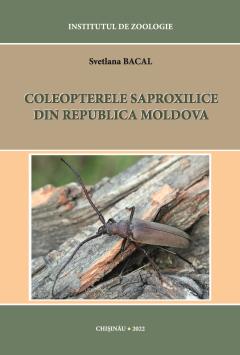- 84 views
The monograph "Saproxylic coleopterans from the Republic of Moldova", author Dr. Assoc.Prof. Svetlana Bacal, presents the results of taxonomic, faunistic and ecological research on saproxylic coleoptera species collected by the author in 2008-2022 and those stored in the collections of the National Museum of Ethnography and Natural History, the Entomology Museum of the Institute of Zoology, the Museum of the State University of Moldova and the Institute of Genetics, Physiology and Plant Protection. In total, 269 species have been identified, of which 43 are new for the fauna of the Republic of Moldova.
The trophic spectrum of the analysed saproxylic coleopterans is of interest: they can be xylophagous species (30%), zoophagous (26%), mycetophagous (19%), or xylophagous/saprophagous (15%), polyphagous (6%), saprophagous (2%), detritophagous (1%), or tree sap consumers (1%).
The book reflects the role of saproxylic coleopterans in the nature and the impact of forest management on the structure and diversity of saproxylic coleoptera species. Thus, from the total number of identified species, 33 (from 13 families) species are indicators of the good ecological condition of the forests.
To highlight the importance of rare species, rarity criteria have been assigned for identified saproxylic coleopterans from the Tenebrionidae family. As a result, 5 species - Platydema dejeani, Neatus picipes, Mycetochara axillaris, Pseudocistela ceramboides and Tenebrio opacus - can be considered critically endangered (CR), 6 species - Hymenalia rufipes, Cryphaeus cornutus, Prionichus ater, Platydema violaceum, Bolitophagus reticulatus and Hypophloeus bicolor - endangered (EN), and 3 species - Diaclina testudinea, Uloma culinaris and Diaperis boleti - vulnerable (VU).
The use of trunk traps allowed the detection of some pest species in the Plaiul Fagului and Pădurea Domnească nature reserves, for example, Xyleborus monographus, X. dispar, Xyleborinus saxesenii, Platypus cylindrus, Scolytus carpini, Xylotrechus rusticus etc., which in favourable conditions can be dangerous and attack forests.
The author believes that for the protection of saproxylic coleoptera species, which are extremely necessary for the normal functioning of forests and which participate in the recycling of dead wood, a volume of at least 50 m3 of dead wood per hectare must be permanently maintained in all forest ecosystems.
https://doi.org/10.53937/9789975347297
Svetlana Bacal, Dr., Assoc.Prof.
